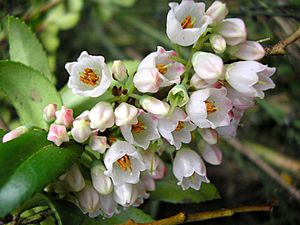Vaccinium membranaceum facts for kids
Quick facts for kids Vaccinium membranaceum |
|
|---|---|
 |
|
| Scientific classification | |
| Kingdom: | |
| (unranked): | |
| (unranked): | |
| (unranked): | |
| Order: | |
| Family: | |
| Genus: | |
| Species: |
V. membranaceum
|
| Binomial name | |
| Vaccinium membranaceum Douglas ex Torr. 1874
|
|
| Synonyms | |
|
|
The Vaccinium membranaceum is a type of huckleberry. People also call it by many other names, like thinleaf huckleberry, tall huckleberry, big huckleberry, and mountain huckleberry. Sometimes, it's even called a "black huckleberry".
Contents
Where It Grows
This huckleberry plant grows naturally in western North America. You can find it from southern Alaska and Yukon down to Utah and northern California. It stretches from the mountains near the Pacific Ocean to the Rocky Mountains and Black Hills.
Some smaller groups of these plants have also been found in places like Arizona, North Dakota, Minnesota, Upper Peninsula of Michigan, and Ontario.
Its Home
Vaccinium membranaceum likes to grow high up in the mountains. It lives in subalpine and alpine areas. You can see it in forests with pine and spruce trees. It also grows in open meadows.
In forests, this huckleberry often takes over the ground layer. It is very good at surviving fires. Its leaves and stems can handle small fires. If they burn away, new shoots will grow back quickly from roots hidden underground.
What It Looks Like
The Vaccinium membranaceum is a straight-standing shrub. It can grow up to about 1.5 meters (5 feet) tall. Its new branches are yellowish-green and a bit angled.
Leaves and Flowers
The leaves fall off each year. They are arranged one after another along the stem. The leaves are very thin and oval-shaped. They can be up to 5 centimeters (2 inches) long. Their edges have tiny teeth, and each tooth has a small, sticky hair.
The flowers grow alone where the leaves meet the stem. Each flower is about 6 millimeters (1/4 inch) long. They are shaped like an urn or a tube. Their color can be pale pink to a waxy bronze. Bees help pollinate these flowers.
Fruit
The fruit changes color as it ripens. It can be red, bluish-purple, or almost black. Each berry is about one centimeter wide. On average, each fruit has about 47 tiny seeds inside.
How It Reproduces
This plant usually doesn't grow from seeds very often. Instead, it mostly spreads by making copies of itself. It does this using its rhizome (an underground stem) or by growing new shoots.
However, seeds can sprout if animals carry them to new places. For example, new huckleberry plants grew from seeds on Mount St. Helens after it erupted. It's quite rare to see this plant grow from seeds. Scientists have only seen a few seedlings over many years of study.
How People and Animals Use It
The Vaccinium membranaceum is the most popular type of wild huckleberry collected in the western United States. It's very important for businesses. In good years, these shrubs produce a huge amount of fruit. People tell stories of mountainsides turning purple from all the berries!
Native Americans and Huckleberries
Both people and wild animals love to eat these berries in late summer and early fall. People have been eating this fruit for thousands of years. Native Americans used it a lot for food, and they still do.
The Kutenai people called the black huckleberry shawíash. Alaska Natives used it in bread and pies because it has a lot of vitamin C. The Coeur d'Alene people ate the fruit fresh, dried, mashed, or cooked. They added it to soup or froze it. Many other groups enjoyed it and stored it for winter. They would freeze it, dry it, press it into cakes, or can it.
Wildlife and Huckleberries
This plant is also a very important food source for animals. Black bears and grizzly bears eat its leaves, stems, roots, and fruit. Elk, moose, and white-tailed deer also munch on the plant. The thick patches of huckleberry plants provide safe places for many small animals to hide.
State Symbol
The huckleberry is the official state fruit of Idaho. This particular species is usually the one people think of when they talk about Idaho's huckleberry.
How It Is Cared For
Some Native American groups used to light small, controlled fires in huckleberry patches. They did this carefully to help the plants grow more fruit. The fires would get rid of other plants that were competing with the huckleberries. They also helped the huckleberry plants sprout and spread. Native American groups in the Pacific Northwest still use this plant as an important cultural food. They are active in helping to manage it.

